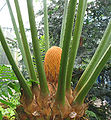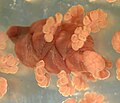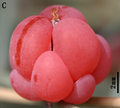Strobilus
Astrobilus(pl.:strobili) is a structure present on many landplantspecies consisting ofsporangia-bearing structures densely aggregated along a stem. Strobili are often calledcones,but some botanists restrict the use of the term cone to the woody seed strobili of conifers. Strobili are characterized by a central axis (anatomically astem) surrounded by spirally arranged ordecussatestructures that may be modified leaves ormodified stems.
Leaves that bear sporangia are calledsporophylls,while sporangia-bearing stems are calledsporangiophores.
Lycophytes[edit]
Some members of both of the two modern classes ofLycopodiophyta(LycopodiopsidaandIsoetopsida) produce strobili. In all cases, the lateral organs of the strobilus aremicrophylls,bearingsporangia.In other lycophytes, ordinary foliage leaves can act assporophylls,and there are no organized strobili.
-
Strobili ofDiphasiastrum
-
Strobili ofLycopodium
-
Liquid-preserved strobili ofLycopodium,showing reniform sporangia through translucent sporophylls
-
Micrograph of the strobilus ofLycopodiumsp., showing spores borne in sporangia
-
Strobili ofSelaginella
-
Liquid-preserved strobili ofSelaginella,showing mega- and microsporangia through translucent sporophylls
Sphenophytes[edit]
The single extant genus ofEquisetophyta,Equisetum,produces strobili in which the lateral organs aresporangiophores.Developmental evidence and comparison with fossil members of the group show that the sporangiophores are reduced stems, rather than leaves. Sporangia are terminal.
-
Strobilus ofEquisetum
-
Strobilus ofEquisetum
-
Liquid-preserved strobilus ofEquisetum,showing sporangiophores
-
Cross-section of liquid-preserved strobilus ofEquisetum,showing sporangiophores bearing sporangia
Seed plants[edit]
With the exception of flowering plants, seed plants produceovulesandpollenin different structures. Strobili bearing microsporangia are calledmicrosporangiate strobiliorpollen cones,and those bearing ovules aremegasporangiate strobiliorseed cones(orovulate cones).
Cycads[edit]
Cycadophytaare typically dioecious (seed strobili and pollen strobili are produced on separate plants). The lateral organs of seed strobili are megasporophylls (modified leaves) that bear two to several marginal ovules. Pollen strobili consist of microsporophylls, each of which may have dozens or hundreds of abaxial microsporangia.
-
Dioon edule,seed cone
-
Cycas circinalis,pollen cone
-
Abaxial surface ofCycas revolutamicrosporophyll, showing microsporangia
Ginkgos[edit]
The single living member of theGinkgophyta,Ginkgo bilobaproduces pollen strobili, but the ovules are typically borne in pairs at the end of a stem, not in a strobilus. When there are more than a pair of ovules inG. biloba,however, or when fossil taxa bearing large numbers of ovules are examined, it is clear that the paired ovules in the extant species are a highly reduced strobilus.
-
Pollen cones ofGinkgo
-
Pollen cone ofGinkgo,showing microsporophylls each with two microsporangia
Conifers[edit]
Pollen strobili ofPinophytaare similar to those of cycads (although much smaller) and Ginkgoes in that they are composed of microsporophylls with microsporangia on the abaxial surface. Seed cones of many conifers arecompound strobili.The central stem produces bracts and in the axil of each bract is acone scale.Morphologically the cone scale is a reduced stem. Ovules are produced on the adaxial surface of the cone scales.
Gnetophytes[edit]
Gnetophytaconsists of three genera,Ephedra,GnetumandWelwitschia.All three are typically dioecious, although someEphedraspecies exhibit monoecy. In contrast to the conifers, which have simple pollen strobili and compound seed strobili, gnetophytes have both compound pollen and seed strobili. The seed strobili ofEphedraandGnetumare reduced, withEphedraproducing only two ovules per strobilus andGnetuma single ovule.
-
Seed cones ofWelwitschia
-
Pollen cones ofWelwitschia
-
Pollen cones ofEphedra
-
Pollen cone ofEphedrashowing microsporangia
-
Ephedra intermediaseed cone.
-
Seed cones ofGnetum
Flowering plants[edit]
Theflowerofflowering plantsis sometimes referred to as abisexualstrobilus.Stamensincludemicrosporangiawithin theanther,andovules(contained incarpels) containmegasporangia.Magnoliahas a particularly strobiloid flower with all parts arranged in a spiral, rather than as clear whorls.
A number of flowering plants haveinflorescencesthat resemble strobili, such ascatkins,but are actually more complex in structure than strobili.
Evolution[edit]
It is likely that strobili evolved independently in most if not all these groups. This evolutionaryconvergenceis not unusual, since the form of a strobilus is one of the most compact that can be achieved in arranging lateral organs around a cylindric axis, and the consolidation of reproductive parts in a strobilus may optimize sporedispersaland nutrient partitioning.
Etymology[edit]
The wordstrobilusis related to the ancient Greekstrobilos= whirlwind. TheHebrewword for conifer cone,itstrubal,is an ancient borrowing from the Greek.
According to Liddell & Scott, the Greek:strobilos (στρόβιλος)had many meanings, generally of anything twisted up...hence of the hedgehog,... of an egg-shell,... as a name of various twisted or spinning objects. For example:
1. a kind of seasnail... 2. a top... 3. a whirlpool, a whirlwind which spins upwards... 6. the cone of the fir or pine, fir-apple, pine-cone,… also of the tree itself.[1]
References[edit]
- ^Henry George Liddell, Robert Scott, assisted by Prof. Henry Drisler of Columbia College: Greek-English Lexicon, 8th ed. 1897 p. 1439. Pub:Harper New York 1882.
- Gifford, E. M. & Foster, A. S. (1988).Comparative morphology of vascular plants,3rd ed. New York: WH Freeman.























